However as expected, the July pattern is turning hot and dry with low moisture content in the soil from a relatively hot and dry June. This is causing a short covering rally in the grains, and at the same time Brazil announces that their corn harvest will be down 25% from forecast, and in France they keep lowering quality and quantity estimates. Last month China announced a big write down of their wheat harvest, now expecting it to be 30% less than expected. Why? excessive rains, and since then it has not stopped raining.
Remember countries and big banks and Food processors want prices cheap and they own the means of communications, but they can't hide the weather very long. La Nina lasts usually two years, and this one will be strong as those follow strong El Nino's usually are. This time we are going to get a boost of cold from both oceans cooling due to their 30 year cycles, and the sun going quiet.
This will magnify the intensity and will drive grain prices much higher. As a side effect, it will kill the Central Banks around the world moves to debase, as it has on the last three strong La Nina's (1999-2000, 2007-2008, and 2011-2012).
We are holding JO, DBA, JJG, WEAT, and Corn (through futures) long term. We also give out a swing trade of buy and sell if you want to more actively manage your position size and drive your cost basis down. www.tradegenius.co)
Make no mistake food prices are going much higher, that is a mathematical certainty.
My video on buy and sell signals on the Ag Stocks.
Below are some news excerpts from Agrimoney and some maps from Weathertrends360.
www.agrimoney.com
https://www.facebook.com/weathertrends360/?fref=ts
Summer-to-Date Classic La Niña Around the World
July 7th, 2016 | wt360
Meteorological Summer is considered 1 June - 31 August so we're 41% done...the Sun say's we're only day 17 into Summer (21 June - 22 September). While NOAA hasn't officially declared it a La Niña Summer yet, the Summer weather pattern around the world is classic La Niña and we can prove it.
Here in the U.S. Summer has been the hottest on record to date with rainfall the least in 4 years and 3rd least in 28 years.
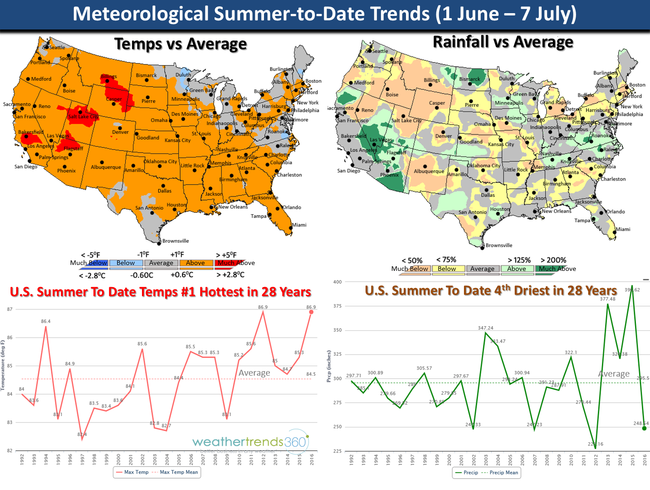
The number of really hot days over 90F across the U.S. is the 2nd most in 25 years.
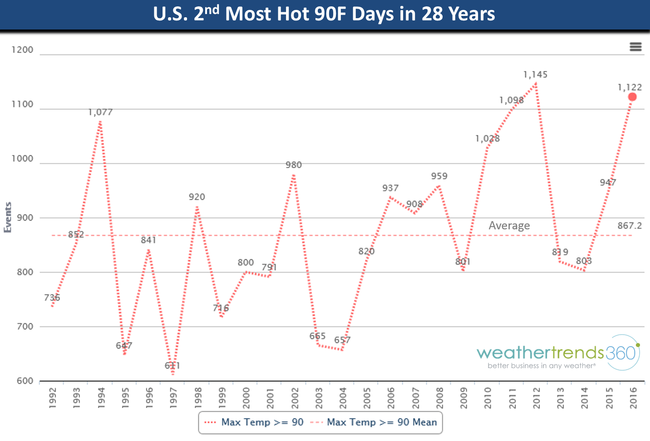
This has drought expanding in parts of the Central U.S. and especially so in the Southeast, Great Lakes and Northeast.
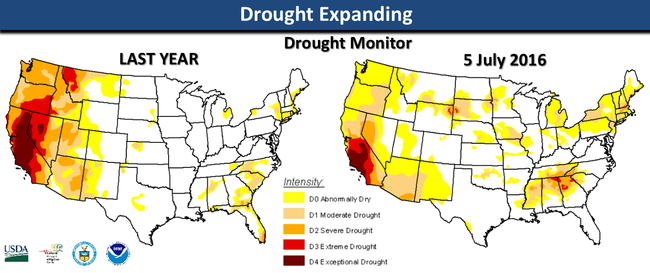
Looking at the ocean temperatures compared to this time last year we see a wholesale change from emerging record strong El Niño to now emerging La Niña.
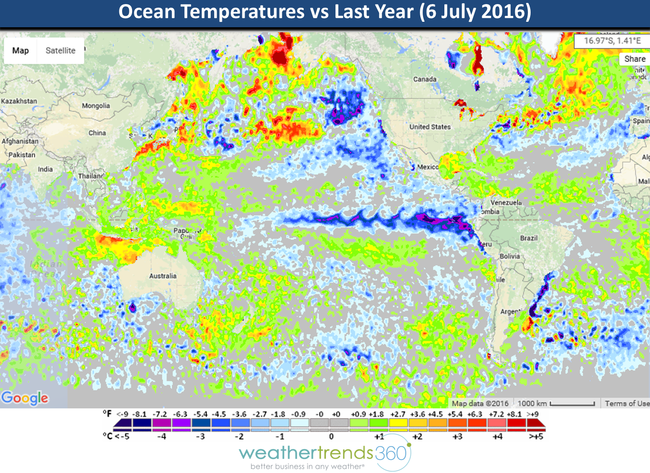
Below the surface of the entire Equatorial Pacific Ocean from Australia to Ecuador we see hundreds of feet of much below normal water temperatures suggesting this La Niña event will go well into 2017.
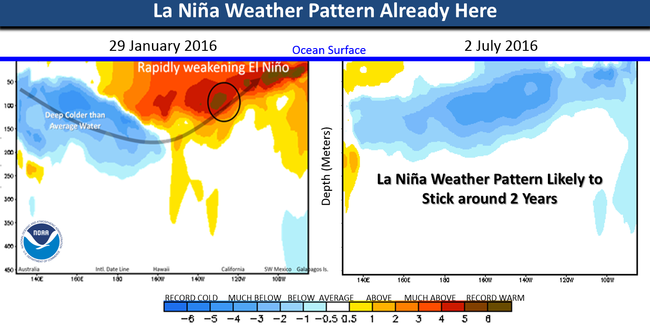
Looking around the world shows classic La Niña with Southeast Asia going from a multi-year El Niño drought to the wettest conditions in 22 years. Australia droughts to wettest in 25+ years. West Africa wettest in over 25 years while the U.S. overall enters a dry pattern. The wet weather in Africa bodes well for a very active core hurricane season for the U.S. so strap in for some potentially major storms in the August - October time-frame.
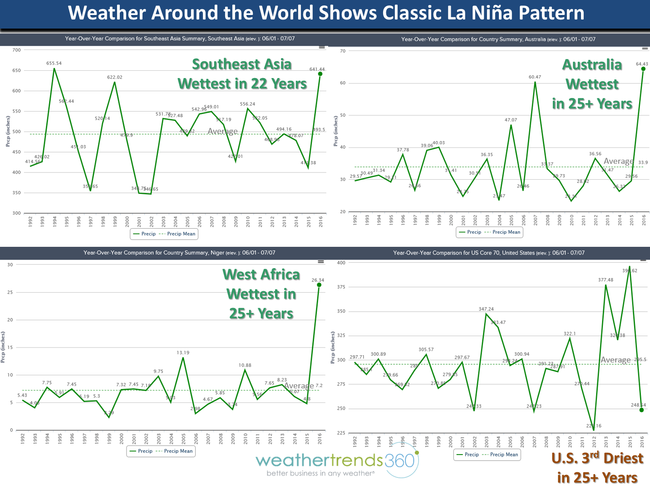
The coldest weather in 25+ years is hitting the Northwest Rocky Mountains which is also a classic sign of La Niña while the Central and Eastern U.S. is about to bake big-time with the 2nd hottest mid-July heat-wave in 28 years.
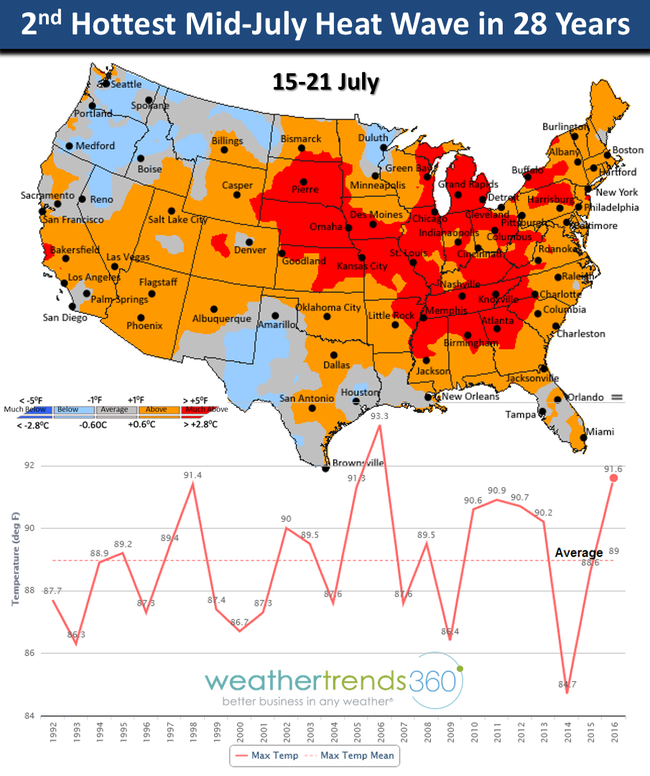
For our farmer friends...keep the faith. Brazil CONAB just came out today (7 July 2016) with huge news that their Safrinha yields just plummeted another 14% from last month's bleak update that was already off 11%. They are now down a whopping 25% off yield projections issued back in March! That should rattle the world commodity markets as now the U.S. can not so much as have a hiccup on yields and we will have a big one! Brighter days ahead for America's Farmers! God Bless You - Keep the Faith!
- Capt Kirk out.
Here in the U.S. Summer has been the hottest on record to date with rainfall the least in 4 years and 3rd least in 28 years.

The number of really hot days over 90F across the U.S. is the 2nd most in 25 years.

This has drought expanding in parts of the Central U.S. and especially so in the Southeast, Great Lakes and Northeast.

Looking at the ocean temperatures compared to this time last year we see a wholesale change from emerging record strong El Niño to now emerging La Niña.

Below the surface of the entire Equatorial Pacific Ocean from Australia to Ecuador we see hundreds of feet of much below normal water temperatures suggesting this La Niña event will go well into 2017.

Looking around the world shows classic La Niña with Southeast Asia going from a multi-year El Niño drought to the wettest conditions in 22 years. Australia droughts to wettest in 25+ years. West Africa wettest in over 25 years while the U.S. overall enters a dry pattern. The wet weather in Africa bodes well for a very active core hurricane season for the U.S. so strap in for some potentially major storms in the August - October time-frame.

The coldest weather in 25+ years is hitting the Northwest Rocky Mountains which is also a classic sign of La Niña while the Central and Eastern U.S. is about to bake big-time with the 2nd hottest mid-July heat-wave in 28 years.

For our farmer friends...keep the faith. Brazil CONAB just came out today (7 July 2016) with huge news that their Safrinha yields just plummeted another 14% from last month's bleak update that was already off 11%. They are now down a whopping 25% off yield projections issued back in March! That should rattle the world commodity markets as now the U.S. can not so much as have a hiccup on yields and we will have a big one! Brighter days ahead for America's Farmers! God Bless You - Keep the Faith!
- Capt Kirk out.
| PM markets: has fund selling run its course? | |
The US Midwest continues to be the focus of grain markets, as corn and soybean futures bounced back on some hotter weather outlooks.
And with funds winding up long positions over the last couple of sessions, analysts suggested that short covering was coming to the fore.
"Short covering has been the rule of the day after another washout of fund longs yesterday, (especially in the soybean complex)," said Darrell Holaday, at Country Futures.
Has fund selling run its course?
Weekly Commitment of Traders data from the Commodity Futures Trading Commission, to be released after markets close, will shed light on fund position in the week to Tuesday, giving a clue as to the hedge fund activity that has been driving markets.
Brian Henry, at Benson Quinn Commodities, said that the "strong recovery in soybeans hints at the idea that the fund selling of the last week has run its course".
But, he commented that "the idea that the funds have liquidated enough length at this point has merit, but we really haven't seen the types open interest reductions the trade is looking for".
Heat raises US concerns
As well as fund positioning, corn and soybeans are benefiting from a less benign weather outlook for the US Midwest.
"Extended forecast maps continue to fluctuate on heat and expected rainfall, causing wild swings in ag commodities," said Paul Georgy, at Allendale.
"The volatility will continue until trade gets a better grasp on the remainder of summer's weather," he warned.
Export sales beat expectations
Soybean sales got a boost from better-than-expected US export sales.
"Soybean sales were mediocre in both marketing years, said Joe Lardy, at CHS Hedging.
US soybean sales for the 2015-16 season were 637,300 tonnes above the top end of expectations.
Sales in the 2016-17 were in-line with expectations, at 585,700 tonnes.
November soybean futures bounced up from two-month lows, to finish at $10.57 ¾ a bushel, up 3.2% a day.
Heat pushes corn higher
US corn export sales for the 2015-16 marketing year were well short of expectations, at just 369,700 tonnes, compared to analyst expectations of 500,000 to 700,000 tonnes.
New crop export sales were in line with expectations, at 443,300 tonnes. Combined old crop and new crop sales were the lowest for 10 weeks.
But fund short-covering and forecast US heat pushed prices higher.
December corn futures finished up 4.2% at $3.62 ½ a bushel, the highest close in the week.
Low prices stir buying interest
Wheat export sales were reported at 825,300 tonnes, well ahead of analyst expectations.
Total wheat commitments for the 2016-17 marketing year now stand 8.5m tons, 36% ahead the same time last year.
Mr Holaday said the wheat sales were "maybe some sign that extremely low prices starting to stir some significant interest".
September Chicago wheat futures finished up 2.5%, at $4.35 a bushel.
French wheat gets another downgrade
FranceAgriMer cut ideas of the French wheat crop to 59% good or excellent as of July 4, down 6 points from last week.
This leaves crop ratings at a five-year low for this time of year.
French wheat ratings are plummeting, after unwanted heavy rain in much of the country.
December wheat futures in Paris rose 2.3%, to E163.75 a tonne.
Good sales lift cotton
Cotton futures rallied, after heavier than expected US export sales.
Weekly US cotton export sales were reported at 201,900 running bales, over three times the pace of last week's sales.
December futures settled up 1.0%, at 65.81 cents a pound.
| |
No comments:
Post a Comment